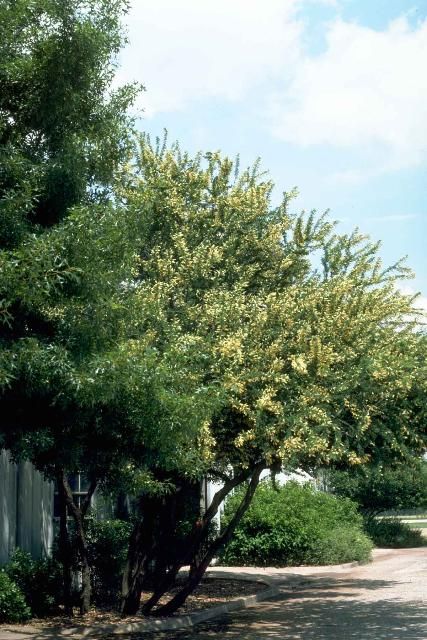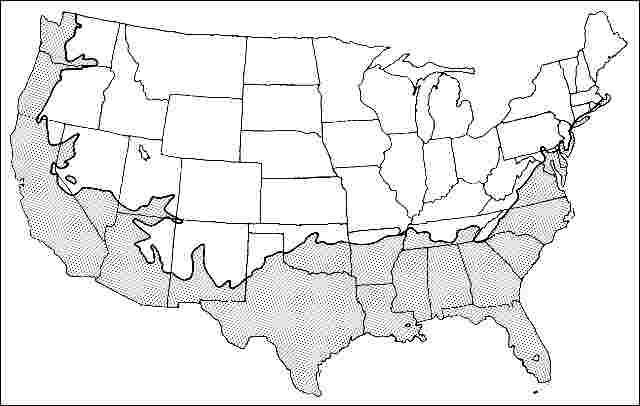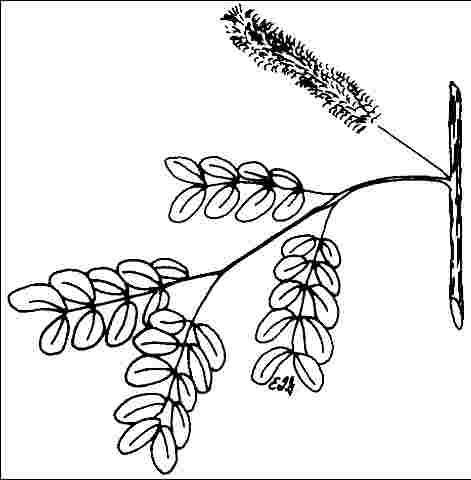Introduction
Quickly growing to 30 feet tall and wide, Wright acacia forms a rounded, open canopy composed of small, bright green leaflets and remains semievergreen in the lower South. The showy springtime displays of 1.5-inch-long spikes of yellow blossoms are abundantly produced over the slightly drooping branches. The blooms are followed by 2-4-inch-long, brown, compressed pods that contain small seeds.

Credit: Ed Gilman, UF/IFAS
General Information
Scientific name: Senegalia wrightii
Pronunciation: Sen-eh-gal-ya RITE-ee-eye
Common name(s): Wright Acacia, Wright Catclaw
Family: Fabaceae
USDA hardiness zones: 7A through 11 (Figure 2)
Origin: native to North America
Invasive potential: not assessed/incomplete assessment
Uses: reclamation; shade; container or planter; deck or patio; specimen; parking lot island < 100 sq. ft.; parking lot island 100–200 sq. ft.; parking lot island > 200 sq. ft.; tree lawn 3–4 feet wide; tree lawn 4–6 feet wide; tree lawn > 6 ft. wide; street without sidewalk; highway median

Credit: UF/IFAS
Description
Height: 25 to 30 feet
Spread: 20 to 30 feet
Crown uniformity: symmetrical
Crown shape: vase, upright/erect
Crown density: moderate
Growth rate: slow
Texture: fine
Foliage
Leaf arrangement: alternate (Figure 3)
Leaf type: even-pinnately compound
Leaf margin: entire
Leaf shape: obovate, oblong
Leaf venation: reticulate
Leaf type and persistence: evergreen
Leaf blade length: less than 2 inches
Leaf color: green
Fall color: no color change
Fall characteristic: not showy

Credit: UF/IFAS
Flower
Flower color: white/cream/gray
Flower characteristics: showy
Fruit
Fruit shape: pod or pod-like, elongated
Fruit length: 1 to 3 inches, 3 to 6 inches
Fruit covering: dry or hard
Fruit color: brown
Fruit characteristics: does not attract wildlife; showy; fruit/leaves not a litter problem
Trunk and Branches
Trunk/bark/branches: branches droop; not showy; typically multi-trunked; thorns
Pruning requirement: needed for strong structure
Breakage: resistant
Current year twig color: gray, brown
Current year twig thickness: thin
Wood specific gravity: unknown
Culture
Light requirement: full sun
Soil tolerances: clay; sand; loam; acidic; alkaline; well-drained
Drought tolerance: high
Aerosol salt tolerance: unknown
Other
Roots: not a problem
Winter interest: no
Outstanding tree: yes
Ozone sensitivity: unknown
Verticillium wilt susceptibility: resistant
Pest resistance: free of serious pests and diseases
Use and Management
Multiple trunks arise from the ground growing into the rounded canopy, which provides moderately dense shade. The tree is well-suited for planting near a patio or deck, or it can make a nice street tree or parking lot tree for hot, dry sites. Little irrigation is required after the tree is well-established in the landscape. The spreading crown can cover an area rather quickly, producing ample shade in a small landscape. Plant trees on 20-foot centers to form an arcade of fine-textured small trees.
Wright acacia should be grown in full sun on well-drained soil. Acacias often develop a thin canopy if grown in partial sun. The somewhat-drooping branches may require regular pruning if planted close to sidewalks or streets to allow passage of vehicles and pedestrians.
Propagation is by seed, which germinate easily, or by collection of small plants.
Pests
No pests are of major concern.
Diseases
No diseases are of major concern.